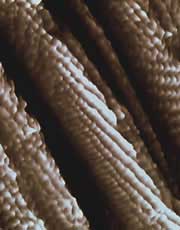Cylinders make circuits spontaneously

Nanotube grids could make compact computer memories. <br>© SPL <br>
Carbon nanotubes assemble themselves into electronic grids
Tiny electrical circuits with a single molecule for each wire have been created in the United States1. These grids could replace silicon chips, making computers and memory devices much more compact and powerful than they are today.
The grids comprise carbon nanotubes – long, hollow cylinders of pure carbon a few millionths of a millimetre (nanometres) across and several thousand nanometres long. Depending on how their atoms are arranged, nanotubes act either as metals (like copper wire) or as semiconductors (like silicon).
The grids practically build themselves – just a little encouragement from electrical fields guides them into place. Putting each wire into place individually would be fiddly, time-consuming and expensive.
James Heath, of the University of California, Los Angeles, and colleagues now demonstrate what they predicted four years ago. Namely that if one or both of two wires crossed at right angles are semiconducting, the junction can act like an electronic device such as a diode. And that each device can, in principle, be switched on or off without affecting the others.
This proof of principle raises hopes that a nanotube lattice could form a computer memory, storing one bit of information at each junction2. Being so small, such a circuit could potentially furnish a random-access memory with a storage density around 100,000 times greater than that of a Pentium chip.
Enough rope
Until now, prototype grids had been built from just a few crossed nanotubes, generally by careful manipulation of individual tubes, or by patterning the surface on which they sit. Heath’s team do away with all this.
They disperse the tubes in an organic solvent. Each single-molecule tube sticks to a few others to form a sort of rope. The ropes are 6-20 nanometres thick, up to 20,000 nanometres long, and electrically charged. By applying an electric field across a silicon wafer, the researchers deposit the tubes on the wafer surface, parallel to the field.
Applying another field perpendicular to the first deposits another set of nanotube ropes that cross the first at right angles. The distance between ropes is more or less constant, because electrical charges cause the ropes to repel each other and settle only if far enough from a neighbour. The researchers control this repulsion to adjust the spacing of the grid.
References
- Diehl, M. R., Yaliraki, S. N., Beckman, R. A., Barahona, M. & Heath, J. R. Self-assembled, deterministic carbon nanotube wiring networks. Angewandte Chemie International Edition, 41, 353 – 356, (2002)
- Rueckes, T.. Carbon nanotube-based nonvolatile random access memory for molecular computing. Science, 289, 94 – 97, (2002).
Media Contact
All latest news from the category: Power and Electrical Engineering
This topic covers issues related to energy generation, conversion, transportation and consumption and how the industry is addressing the challenge of energy efficiency in general.
innovations-report provides in-depth and informative reports and articles on subjects ranging from wind energy, fuel cell technology, solar energy, geothermal energy, petroleum, gas, nuclear engineering, alternative energy and energy efficiency to fusion, hydrogen and superconductor technologies.
Newest articles

Durable, Efficient, Sustainable: The Rise of Cerium Oxide Thermal Switches
Groundbreaking cerium oxide-based thermal switches achieve remarkable performance, transforming heat flow control with sustainable and efficient technology. Cerium Oxide-Based Thermal Switches Revolutionize Heat Flow Control Thermal switches, which electrically control…

How Industrial Robots are Reducing Emissions in Global Manufacturing
A new study explores the intersection of industrial automation and environmental sustainability, focusing on the role of industrial robots in reducing the carbon intensity of manufacturing exports. The research demonstrates…

Patients Can Heal Through Precise, Personalized Bioceramic Grafts
A recent review is transforming the landscape of craniomaxillofacial bone regeneration with the introduction of personalized bioceramic grafts. This pioneering research explores the fabrication and clinical potential of synthetic grafts…



